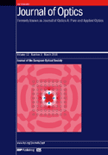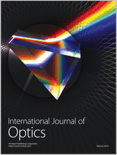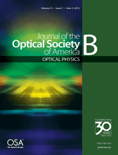
JOURNAL OF MODERN OPTICS
Scope & Guideline
Transforming Insights into Optical Applications
Introduction
Aims and Scopes
- Optical Communication Systems:
Research focusing on advancements in optical communication technologies, including free-space optics (FSO), wavelength-division multiplexing (WDM), and other innovative transmission methods for high-speed data communication. - Photonic Devices and Materials:
Investigation into novel photonic materials and devices, such as metamaterials, photonic crystals, and various optical sensors, aimed at enhancing performance in applications ranging from imaging to sensing. - Optical Imaging and Sensing Techniques:
Development of advanced imaging techniques including optical coherence tomography, phase retrieval, and image encryption, which are crucial for applications in medical imaging, security, and remote sensing. - Nonlinear Optics and Quantum Optics:
Exploration of nonlinear optical phenomena and quantum optics, including studies on solitons, entanglement, and quantum state manipulation, contributing to the foundational understanding necessary for future quantum technologies. - Machine Learning in Optics:
Application of machine learning and artificial intelligence techniques to optimize optical systems, enhance image processing, and improve the performance of optical sensors and communication systems.
Trending and Emerging
- Machine Learning and Artificial Intelligence in Optics:
An increasing number of publications are exploring the integration of machine learning algorithms and AI techniques in optical research, enhancing data analysis, image processing, and system optimization. - Metamaterials and Novel Optical Structures:
Research on metamaterials and complex optical structures is gaining traction, focusing on their unique properties and potential applications in sensing, imaging, and communication technologies. - Quantum Technologies and Photonics:
There is a significant rise in interest surrounding quantum optics and photonics, particularly in areas such as quantum communication, quantum cryptography, and the manipulation of quantum states. - Hybrid Optical Systems:
Emerging studies are focusing on hybrid systems that combine various optical technologies, such as integrating optical and electronic components, to improve functionality and performance. - Advanced Imaging Techniques:
Innovative imaging techniques, including phase retrieval and compressive sensing, are trending as researchers seek to enhance imaging capabilities in various fields, from medical diagnostics to remote sensing.
Declining or Waning
- Traditional Optical Materials Research:
Research on conventional optical materials, such as simple glass and standard polymers, appears to be declining as the focus shifts towards advanced materials like metamaterials and nanostructured devices. - Basic Theoretical Studies:
Publications that focus exclusively on theoretical approaches without experimental validation are becoming less common, as there is a growing preference for studies that bridge theory with practical applications. - Conventional Imaging Techniques:
There is a noticeable reduction in studies centered around traditional imaging techniques, such as basic lens systems, as researchers increasingly explore more advanced imaging methods that leverage novel technologies. - Optical Systems for Specific Applications:
Research pertaining to highly specialized optical systems, such as those designed for niche applications, is witnessing a decline, possibly due to the broader applicability of more versatile technologies.
Similar Journals

Ukrainian Journal of Physical Optics
Leading the Charge in Optical Physics ScholarshipThe Ukrainian Journal of Physical Optics is a premier publication dedicated to advancing the field of optical physics, particularly strong in atomic and molecular physics. Founded in 2000 and published by INST PHYSICAL OPTICS, this journal has established itself as a leading platform for innovative research and scholarly discourse in optics, ranking in the top quartile (Q1) within its category according to the 2023 metrics. With an impressive Scopus rank of #30 out of 224 journals in the field, the journal garners significant attention, claiming an 86th percentile ranking that underscores its academic prestige. Researchers, professionals, and students alike will find a wealth of cutting-edge studies and insights within its pages, supported by open access options, which ensures global dissemination of knowledge. As the journal continues to converge into 2024, it remains a vital resource for those seeking to explore the depths of physical optics and contribute to the evolving landscape of this dynamic field.

Journal of Optics
Illuminating the Future of OpticsThe Journal of Optics, published by IOP Publishing Ltd, stands as a pivotal platform for disseminating cutting-edge research in the fields of atomic, molecular physics, and optics as well as electronic, optical, and magnetic materials. With an impact factor reflective of its esteemed position—ranking in the 60th percentile in both relevant Scopus categories—this journal, boasting an ISSN of 2040-8978 and an E-ISSN of 2040-8986, is uniquely positioned to foster innovation and collaboration among researchers, professionals, and students worldwide. Located in the United Kingdom and operational since 2010, the journal embraces an open access model, promoting maximal reach and engagement with the latest discoveries that shape the future of optics. As it continues to evolve through its converged years up to 2024, the Journal of Optics remains a critical resource for those seeking to advance their knowledge and influence in this dynamic field.

Chinese Optics
Nurturing Excellence in Optical Research and Collaboration.Chinese Optics is a premier journal dedicated to advancing the field of optics, encompassing research on atomic and molecular physics. Published by the esteemed Changchun Institute of Optics Fine Mechanics & Physics in China, this journal supports the sharing of cutting-edge findings since its inception in 2010. With an ISSN of 2097-1842, it operates within a competitive landscape, currently positioned in Q3 of the category for Atomic and Molecular Physics and Optics, according to the 2023 metrics. While the journal is not open access, it offers a valuable platform for researchers, professionals, and students to explore and contribute to significant discoveries in the realm of optics and light technology. By fostering scholarly communication, Chinese Optics plays a crucial role in bridging theoretical and practical aspects, making it an indispensable resource for those passionate about the optical sciences.

OPTICA APPLICATA
Advancing Research in Atomic and Molecular PhysicsOPTICA APPLICATA, published by Wroclaw University of Science and Technology, is a crucial platform for advancing knowledge in the fields of Atomic and Molecular Physics and Optics. With an ISSN of 0078-5466 and an E-ISSN of 1899-7015, this journal serves as a vital resource for researchers, professionals, and students seeking to explore the latest developments and applications in optical science and engineering. Although currently categorized in the fourth quartile in both Atomic and Molecular Physics and Electronic, Optical and Magnetic Materials, its commitment to publishing high-quality research articles, reviews, and technical notes remains unwavering. The journal covers diverse topics from practical applications to theoretical insights and fosters a collaborative environment for global contributors. While it does not offer an open access option, the journal is accessible through university libraries and institutional subscriptions. With an eye towards bridging academic research with real-world applications, OPTICA APPLICATA is well-positioned to influence advancements in photonics and materials science through ongoing issues from 1988 to 2024.

International Journal of Optics
Innovating Interdisciplinary Applications of OpticsWelcome to the International Journal of Optics, a distinguished publication dedicated to advancing the field of optics and its interdisciplinary applications. Published by HINDAWI LTD, this open-access journal has been pivotal in fostering knowledge since its inception in 2009. With a robust focus on atomic and molecular physics as well as electronic, optical, and magnetic materials, the journal has carved its niche within Q3 quartile rankings in these categories for 2023, signifying its growing impact and relevance in the scientific community. Researchers and professionals will find a rich repository of innovative and cutting-edge research articles that not only address fundamental aspects of optics but also explore practical applications across various domains. The journal's aim is to promote high-quality research dissemination, enhancing collaboration among scientists and ensuring that pivotal findings reach a global audience. Join us in exploring the dynamic world of optics—where your contributions help shape the future of science.

Photonics, an esteemed journal published by MDPI, is a leading platform for researchers in the fields of atomic and molecular physics, optics, and instrumentation. Since its inception in 2014, the journal has fostered open access to cutting-edge research, facilitating knowledge dissemination in these dynamic disciplines. With its Q2 ranking in the 2023 Scopus metrics for various categories, including radiology, nuclear medicine, and imaging, Photonics represents a crucial academic resource for professionals and students seeking to advance their understanding and expertise. Located in Basel, Switzerland, the journal plays a pivotal role in bridging theoretical and practical approaches to photonic technologies. Researchers are encouraged to contribute their findings, thereby enriching the journal’s impact and relevance in the global scientific community through collaboration and innovation.

Optoelectronics Letters
Fostering Innovation in Light and MatterOptoelectronics Letters, published by Tianjin University of Technology, is an esteemed platform for the dissemination of innovative research within the fields of atomic and molecular physics, optics, condensed matter physics, and electrical engineering. With its inaugural publication in 2007 and a convergence period extending to 2024, this journal aims to foster scholarly communication and collaboration among researchers and professionals. Although currently lacking an impact factor, it serves a vital niche in the rapidly evolving field of optoelectronics, evidenced by its categorization in the fourth quartile for various physics disciplines and the third quartile in electrical and electronic engineering. Given its ranking dynamics in Scopus, it is an emerging choice for authors seeking to convey their findings on electronic, optical, and magnetic materials. Researchers, students, and industry professionals alike can benefit from its open access options, encouraging a broad dissemination of cutting-edge knowledge that is essential in the advancement of technology and materials science.

OSA Continuum
Fostering Innovation Across Disciplines in OpticsOSA Continuum, published by the Optica Publishing Group, is a distinguished open access journal dedicated to advancing research in the realms of Atomic and Molecular Physics, Optics, and Electronic and Electrical Engineering. Since its inception in 2018, this journal has rapidly positioned itself as a significant platform for disseminating cutting-edge findings, achieving impressive Scopus rankings with a 61st percentile in Electrical and Electronic Engineering and 57th in Atomic and Molecular Physics. Based in the United States, the journal not only promotes scholarly dialogue among researchers and professionals but also plays a crucial role in bridging theoretical advances with practical applications in optical and material sciences. Its open access format ensures broader visibility and accessibility of research outputs, fostering innovation and collaboration across disciplines. With its ongoing commitment to excellence, OSA Continuum is crucial for anyone involved in these dynamic fields.

OPTICS COMMUNICATIONS
Connecting Ideas Through Light and InnovationOptics Communications, published by Elsevier, is a prestigious international journal that focuses on the dynamically evolving fields of optics and photonics. With its ISSN 0030-4018 and E-ISSN 1873-0310, this journal has made significant contributions to the fields of Atomic and Molecular Physics, Electrical and Electronic Engineering, Electronic, Optical and Magnetic Materials, and Physical and Theoretical Chemistry, consistently ranking in the Q2 quartile across these categories for 2023. The journal, based in the Netherlands, is recognized for its rigorous peer-review process and aims to publish high-quality research articles that advance knowledge and applications in optical communication technologies. Although it operates under a subscription model, the insightful research published here plays an essential role in informing the work of researchers, professionals, and students alike. With a history dating back to 1969 and spanning well into 2025, Optics Communications remains a crucial resource for cutting-edge developments in optics, catering to a global audience dedicated to innovation in this pivotal science.

JOURNAL OF THE OPTICAL SOCIETY OF AMERICA B-OPTICAL PHYSICS
Leading the Charge in Optical Physics InnovationJOURNAL OF THE OPTICAL SOCIETY OF AMERICA B-OPTICAL PHYSICS, published by Optica Publishing Group, serves as a leading platform for groundbreaking research in the fields of optical physics, atomic and molecular physics, and statistical and nonlinear physics. With an ISSN of 0740-3224 and an E-ISSN of 1520-8540, this esteemed journal has been in circulation since 1984 and is dedicated to advancing the understanding of optical phenomena and related technologies. It holds a commendable position in the academic community, with a 2023 Scopus ranking reflecting its significance—placing it in the top quartile for both Atomic and Molecular Physics and Statistical and Nonlinear Physics. Although it is not an open-access publication, it provides extensive access options to ensure that research is disseminated effectively within the scientific community. This journal is instrumental for researchers, professionals, and students alike, aiming to keep them informed of the latest advancements and trends in optical science. With a convergence of expertise and innovation, JOSA B continues to play a pivotal role in shaping the future of optical research.